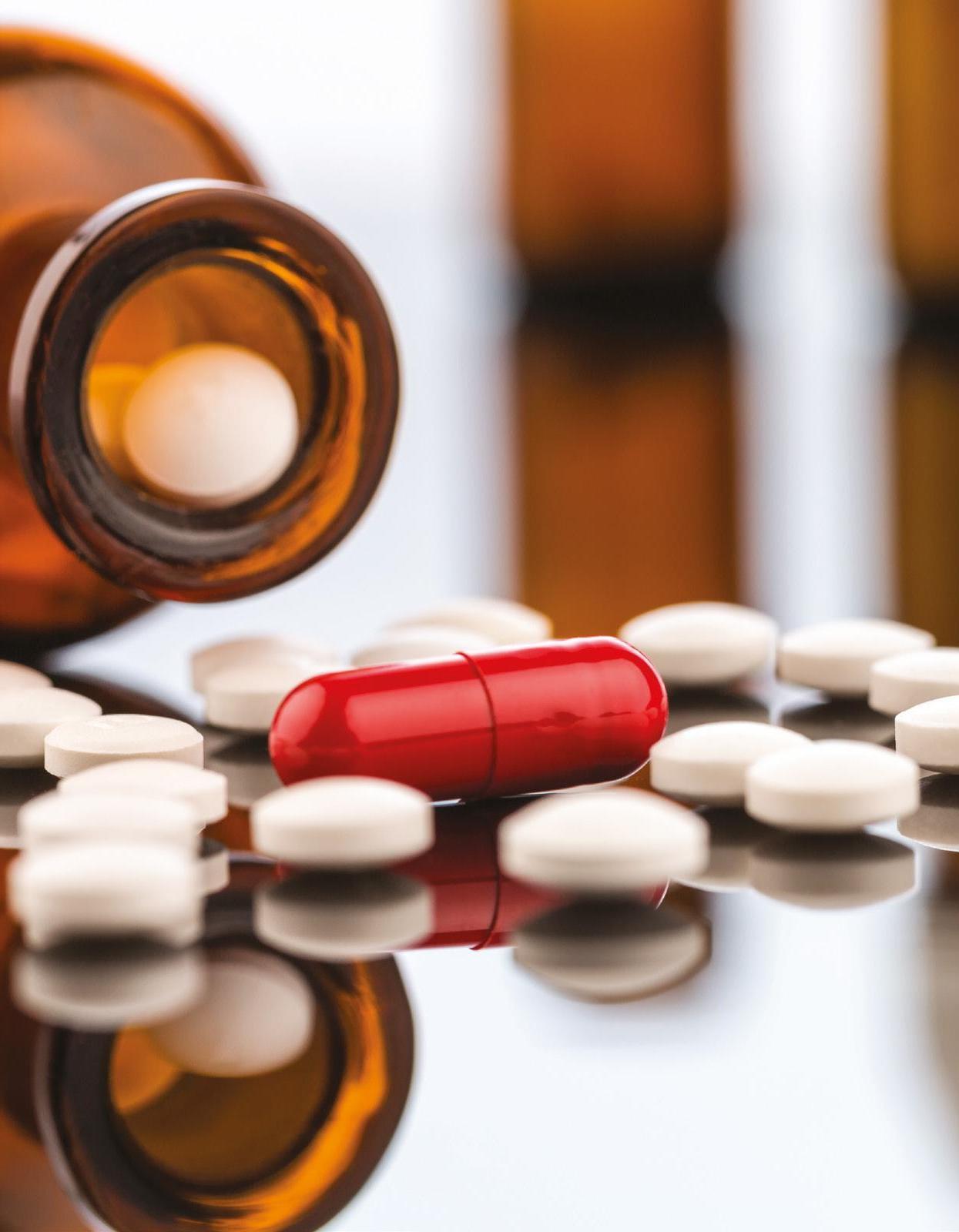
6 minute read
Roisin Ni Chleirigh shows the way
Jordi Mascio of Goldman Laboratories explains why many of us would benefit from more glutathione…
Discovering
GLUTATHIONE is a peptide made up of three amino acid units produced by the liver as well as by brain cells. It primarily performs anti-oxidant and anti-aging actions in the body by reducing the oxidative damage to body cells. It is essential for breakdown of nutrients, regulation of immune responses, Glutathione offers protection against oxidative stress and helps control energy expenditure in the body particularly for muscle energy regulation. It has the ability to exist in reduced (GSH) and oxidized forms (GSSG) in the body. The ratio (GSH/GSSH) of the two forms is an indicator of cell’s redox status. Healthy cells are rich in reduced form (GSH) of glutathione. Under stress conditions, the ratio favors the oxidised form (GSSH) in the cells as there is increased energy usage. Glutathione acts as a shield for cells to protect them from inflammation and the reactive free radicals produced by toxins in the body which are produced as a result of normal metabolic activity or as environmental toxins. It neutralises the reactive ability of toxins in the body particularly the toxic metal ions such as mercury and lead. Glutathione offers cells protection from oxidants through salvaging vitamins C and E. Glutathione must be sufficiently available in the body as it is critical for the maintenance of optimum health and shielding the body from the harms of toxins and poisons.
What if Glutathione is depleted in the body?
With aging and under the influence of repetitive exposure to oxidating toxins and chemicals, the body’s cells decrease the production of this essential antiaging peptide, which leads to a slower metabolism and increase in toxins that promote neurodegeneration of brain cells (as in Alzheimer’s disease), decreased immunity (autoimmune diseases as arthritis), risk of long-term age-related diseases (such as cataracts, glaucoma oxidation and aging in the body).
The activity of Glutathione in detoxifying and acting as an anti-oxidant is an indicator of lifespan of a person.
Studies show that depleted levels of glutathione have been associated with fatigue as the energy producing cell mitochondria become damaged and start accumulating inside the cell causing toxicity. Mitochondria provide about 90% of energy requirements of body.
Glutathione has a role in the formation of genetic material and building blocks of cell macromolecules, supporting healthy immune function, forming sperm cells and aiding in fertility, breaking down free radicals, enzymes functionality and acting as cofactor in various metabolic reactions. It also restores vitamins C and E, thus lowering the risk of cancer, as well as transporting mercury out of the neuronal cells, helping the liver and gallbladder in metabolism and storage of fats and supporting steady cell death. Its depletion can lower the normal working capacity of the body and affect multiple body functions.
One can boost the levels of glutathione in the body by reducing the oxidative stress. This can include simple measures such as taking a good night sleep of at least 7hrs, managing stress, limiting alcohol intake, boosting immunity by means of vitamins particularly A, D and C, supplementation with milk thistle, Folate, B6, B12, Curcumin, N-acetyl cysteine and superoxide dismutase, and eating more whole foods, almonds, dark leafy greens, unprocessed meat, garlic, broccoli, asparagus, avocados, spinach and bell peppers. It has been noted that people who practice meditation have a 20% higher level of glutathione in their bodies due to following a stress-free lifestyle.

Testing for glutathione depletion
GGT (gamma-glutamyl transferase) is an indicator of measure of glutathione depletion as it is increased in comparison to the ‘need’ for glutathione. It can be tested for using a blood sample. Increase in GGT is linked to many diseases such as diabetes, metabolic syndrome, coronary artery disease, cancer, fatty liver disease, and hypertension. The normal GGT levels is considered to lie between GGT 30-40. Someone with GGT levels of 40-50 is considered to have 20 times higher risk of diabetes.
The anti-oxidant effects of Glutathione
A special characteristic of glutathione lies in the sulfur atom, which itself has detoxification properties and has been used as a detoxifier for thousands of years, contained within the amino acid cystine. Sulfur atom’s peculiar chemical structure attracts free radicals thus scavenging them and quenching their reactive thirst. Oxidative stress itself can make cells stronger to the effects of reactive species over time. However, free radicals can induce damage to vital parts of a cell such as genetic material, proteins, DNA and cell membranes through an electron capture action called oxidation. Cells can become fragile and lose their permeability and become unable to function normally which in some cases results in premature cell death or necrosis. Production of reactive oxygen species (ROS) in excess induces tissue injury which proceeds to widespread inflammation. By binding to and eradicating oxidative species, glutathione can decrease oxidative stress on the body and consequently improve inflammation.
The detoxifying role of Glutathione
Glutathione helps to cleanse and neutralize poisons and toxins formed in the liver, lungs, intestines and kidneys as a byproduct of normal metabolism. Toxins in the body are stored in the fat. Glutathione binds to toxins thus nullifying their toxic potential and helps in the detoxification and elimination of toxins, solvents, pesticides, polycyclic aromatic and heavy metals that are transported to or stored in the fatty tissue. It is especially concentrated in the liver where it plays a major role in phase II detoxification reactions, the stage in which glutathione binds to toxic molecules to prepare them to be removed from the body.
The role of Glutathione in muscle metabolism
Physical exercise decreases the reduced form (GSH) and increases the oxidized form of glutathione. Prolonged exercise decreases total cell glutathione content over time. An upsurge in oxidized glutathione (GSSH) after prolonged high intensity exercise with a contrary concurrent decrease in reduced glutathione (GSH) is notable after exercise.
Blood glutathione increases during prolonged exercise and carbohydrate supplementation may prevent blood GSH increase possibly due to inhibition of hepatic hormones, which stimulate GSH activity. Aging related loss of muscle mass and strength is an important risk factor for accelerating rates of physical disability. Glutathione is a key participant in building muscle mass and strength as it helps to preserve the muscle protein synthesis pathway.
Many elderly individuals are prescribed physical therapy programs. Glutathione supplementation may help enhance the intended outcomes of these programs. It enhances performance of muscle cells making them stronger to withstand exercise load and supports in faster muscle recovery. Muscle building requires the body to slow down giving your muscles time to recover and for lactic acid to diffuse from cells.
Glutathione can increase the number of mitochondria in the muscle cells, stop lactic acid from accumulating in muscles after exercise and can postpone fatigue accompanying with exercise. Glutathione possesses the ability of GSH to stabilize and slowly release Nitric Oxide (NO) and improves its effectiveness in exercise related dilation of blood vessels thereby supplying more blood to the muscles and by protecting NO from oxidative damage. Moreover, faster muscle repair is seen with the supplementation of glutathione in an exercise regimen. n
iJORDI MASCIO holds an MSc in Bio Medical Engineering and another in MSc in Molecular Physics. He provides courses and seminars on liposomes and innovative molecules to many practitioners around Europe
www.goldmanlaboratories.com










